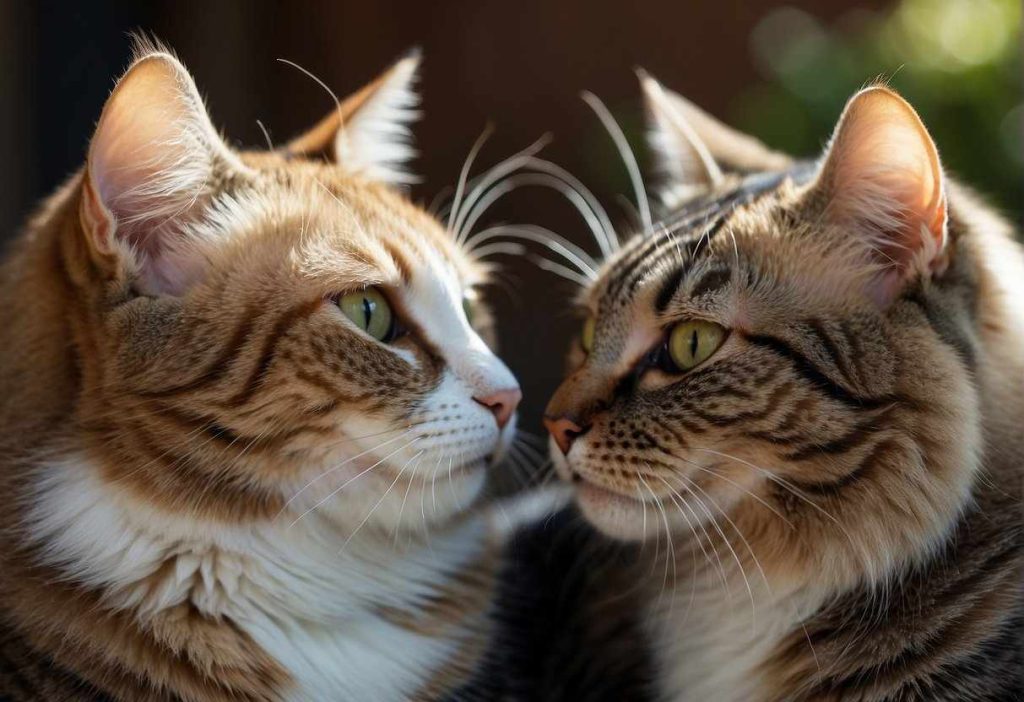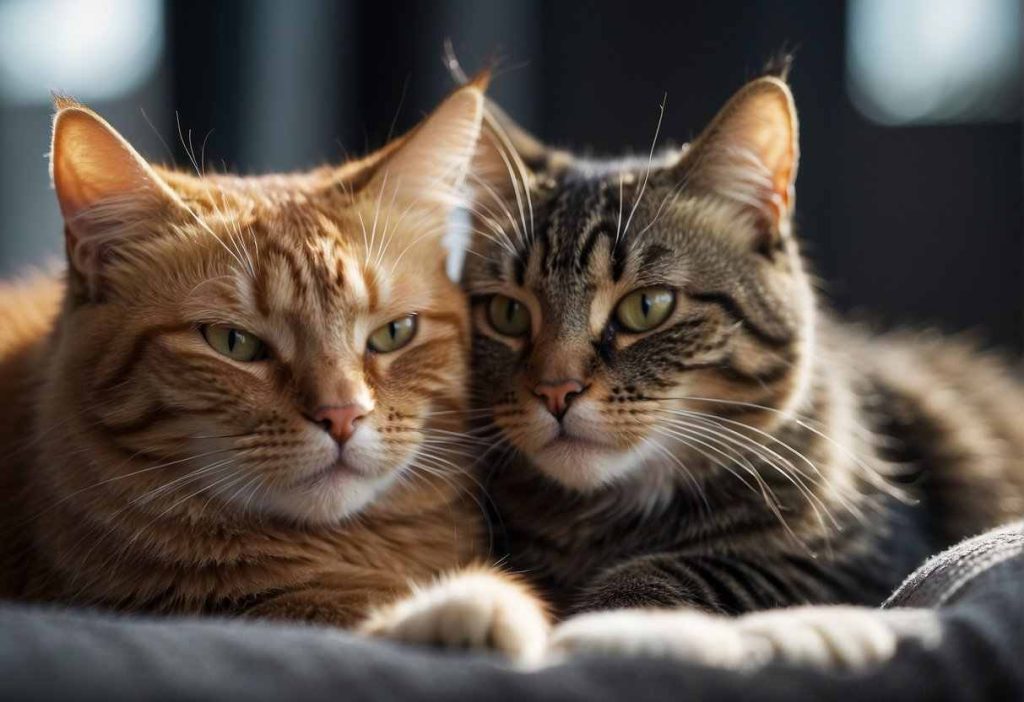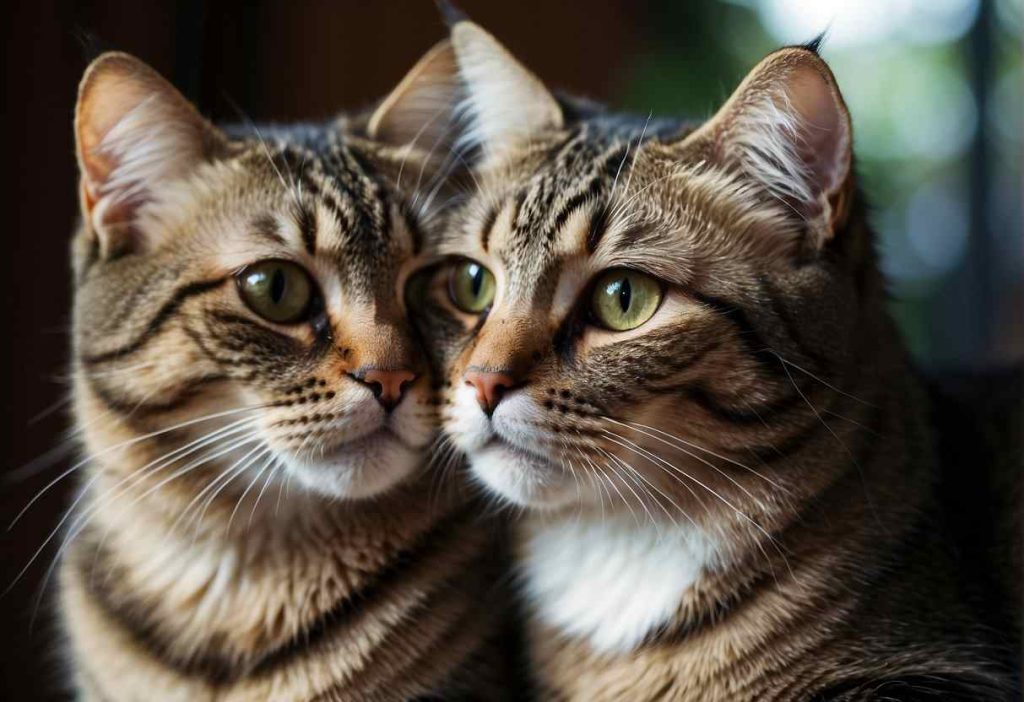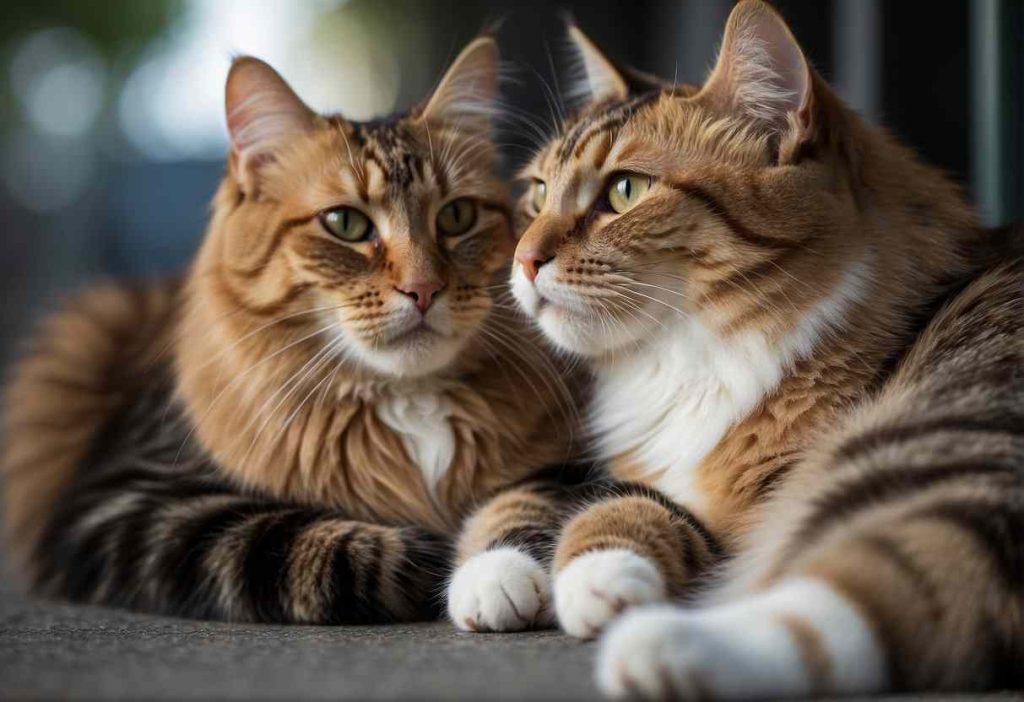When pondering the complexities of our feline friends’ behavior, one question that might tickle your curiosity is: Can cats be gay?
It’s a notion that often emerges from observing the close bonds and interactions between same-sex cats. (1)
In human terms, we’re quick to slap a label on behaviors that seem to mirror our own – but are these labels accurate or just a cozy blanket of human interpretation?

We humans have a knack for seeing ourselves in our pets. The way they cuddle, groom each other, or even play fight can have us raising an eyebrow and pondering their romantic lives.
However, applying human social and sexual norms to cats is a classic case of anthropomorphism.
It’s essential to peel back our human perspective and consider the inarguable differences between human and feline behaviors.
After all, cats don’t carry the same social complexities or constructs as we do, and their actions are driven by instinct far more than any conscious decision akin to human sexuality.
Key Takeaways
- Cats may display behaviors that seem gender-preferential, sparking inquiries into their sexual orientation. (2)
- Anthropomorphism can lead to misinterpretation of feline behavior, as cats do not have the same social constructs as humans.
- Understanding feline behavior requires an observation of their actions without the bias of human social norms.
Can Cats Be Gay?
Observing Same-Sex Behavior in Cats
- You may see two male cats grooming each other frequently.
- Two female cats may rest closely entwined and show what looks like affection.
- Some cats exhibit mounting behavior, which is often mistaken for a sexual act, regardless of gender.
Scientific Perspective on Feline Sexuality
Expert Opinions and Studies
- Research typically does not frame cat behavior in terms of human sexuality. (3)
- Studies suggest many behaviors initially interpreted as sexual are often about dominance or affection.
Biological Vs. Social Behaviors
- Mounting can be about establishing social order rather than mating.
- Cats rubbing against each other is a way of sharing scent, not necessarily a romantic gesture.
- Play-fighting is common and part of social interaction, not an indication of sexual preference.
Myths and Misconceptions
- It’s a myth that cats can be gay in the human context of sexuality.
- Some believe cats showing affection to same-sex companions means they’re gay, but this is a misinterpretation.
- The idea that certain behaviors are exclusive indicators of a cat’s sexual orientation is unfounded.
Demystifying Feline Sexuality

Scientific Background on Animal Sexuality
It’s quite different from human sexuality in many ways.
Animals don’t date or have romantic dinners; instead, their behaviors are driven primarily by the instincts for mating and reproduction.
Understanding “Gay” Behavior in Cats
So, what about those times when you see two male cats, for instance, engaging in what looks like mating behavior?
It might look pretty clear-cut to you, but it’s not always about sexual preference.
Sometimes, animals exhibit behaviors similar to those we’d call “homosexual,” but they can occur for multiple reasons such as dominance, playfulness, or social bonding.
Does this mean your cat can be gay? The question itself is tricky.
Cats, and animals in general, don’t have sexual orientations in the way humans understand and define them. They act predominantly on instinct, not emotional or romantic attraction.
- Cats show affection differently from humans. They might cuddle with the same sex without any sexual connotations. (4)
- ‘Mounting’ isn’t always a sexual behavior. It might also be about social hierarchy.
Next time you see behaviors among your cats that make you question their sexuality, remember it might be their natural way of communicating and interacting within their social structures.
A little patience and observation can reveal that what might look like sexual behavior is just part of a wide spectrum of feline interactions. They’re complex creatures, and their interactions are as multifaceted as their personalities!
Insights from Veterinary Science and Ethology

What Experts Say
Well, veterinary behaviorists have weighed in, and their observations of animal behavior, including that of our purring pals, offer some intriguing insights. (5)
Cats, just like other animals, display a variety of behaviors that can be complex and sometimes even appear to mirror human social patterns.
Experts in animal behavior have seen various instances of cats showing affection towards cats of the same sex.
While it’s easy to humanize these actions and label them, it’s important to note that behaviors such as cuddling or grooming are not necessarily indicative of sexual preference, but rather social bonding or hierarchy establishment.
Current Research on Feline Behaviors
- Same-Sex Behavior in Cats: Surprisingly, there’s a lack of in-depth research that focuses solely on same-sex behavior in domestic cats. However, ethologists—scientists who study animal behavior in natural conditions—have documented such behaviors in multiple species, noting it could be about dominance, territory, or social cohesion.
- Analysis of Research Limitations: It’s crucial to understand that animal behavior doesn’t always equate to that of humans. The reasons behind certain actions are often rooted in instinctual drives rather than the human concepts of romantic or sexual orientation.
- Implications of Findings: The limited studies that do exist highlight that we have a lot to learn about our feline friends.
- Any observed behavior that may appear as “homosexual” should be interpreted with caution, acknowledging that human social constructs don’t always directly translate to the animal kingdom.
When diving into the kitty cosmos, keep it clear: our current framework for understanding feline behavior is continually evolving, and without explicit data or studies, we maintain a paws-off approach to labeling their love lives.
After all, the mystery is part of the charm, isn’t it?
Observing Cat Behavior: Beyond the Human Lens

Commonly Misinterpreted Behaviors
Have you ever spotted your feline friend grooming another cat for what seems like hours? Or maybe you’ve seen them head butt you affectionately or even caught them in the act of mounting another kitty.
It’s easy to slap human-like labels on these behaviors, but let’s scratch beneath the surface:
- Grooming: Cats are notorious for keeping themselves squeaky clean. When they groom each other, it’s not just about cleanliness; it’s a sign of trust and bonding.
- Head Butting: Your cat bumping their head against you isn’t them getting ready to charge. It’s actually a way they show affection and mark you as part of their family using the scent glands on their head.
- Mounting: Despite what it may look like, mounting can be more about showing who’s boss rather than a romantic escapade.
The Role of Social Hierarchies and Instincts
Here’s the scoop on how they figure out who’s the top cat:
- Dominance: Just like teenagers jostling for the spotlight, cats use behaviors like mounting to establish a pecking order.
- Play: Those mock battles aren’t the real deal. Cats, especially youngsters, play-fight as a way to learn the ropes of cat life.
- Mating Instincts: During breeding season, cats might exhibit a range of behaviors directed by their instincts. It’s nature’s way, not a choice or preference.
The dynamics in your furry friend’s world are intricate. Understanding their behaviors without jumping to human-centered conclusions gives you a clearer picture of what’s really going on in their mysterious minds.
So next time you catch them in a quirky act, remember: you’re observing a complex social structure that’s all cat.
Addressing Anthropomorphism in Understanding Cats

The Impact of Human Interpretations
Ever caught yourself chuckling at a cat acting ‘just like a little person’?
It’s natural to see a bit of ourselves in our feline friends, but when we slip on our human-tinted glasses, we may get their behaviors all wrong.
- Why should we be careful? Human interpretations can lead to:
- Mischaracterizing cat behaviors
- Misunderstanding their needs and responses
How can you stay unbiased? Well, let’s think like a cat:
- Observe without interference
- Compare behaviors across situations
- Look for patterns without adding a narrative
Ethical Considerations
When discussing their interactions, especially those resembling human sexual orientations, we tread on thin ice, ethically speaking.
- What’s the big deal? Applying human social constructs can be misleading.
- It can affect how we treat and care for them.
So, what’s the take here?
We adore our cats and sometimes forget they aren’t little people in fur coats.
By appreciating their behaviors without human bias, you’re respecting their true nature. Isn’t that what being a great cat buddy is all about?
Nurturing Healthy Relationships with Our Cats

Supporting Your Cat’s Behavioral Health
Environmental enrichment is key!
Provide scratching posts, toys, and regular playtime to keep your cat stimulated.
Remember, climbing trees and perches offer great vantage points for your curious companion.
Cats communicate through body language, so keep an eye out for signs of stress like excessive grooming or hiding.
If you notice these, it’s time to consult a vet or a feline behaviorist. They’re the experts who really get what makes your whiskered friend tick!
Fostering a Deeper Bond
Cats aren’t just adorable, they’re complex creatures with unique personalities. If you’re keen to create a meaningful connection, observe your cat’s behavior.
Are they a dawn and dusk hunter or an all-day lounger? Match your interaction to their schedule to maximize bonding time.
Fun fact: A slow blink means “I love you” in cat language. Try it out, and look for that loving blink in return!
It’s a simple but profound way to say you both care.
- Key Actions for a Healthy Relationship:Play often. Use interactive toys like laser pointers or feather wands.
- Respect their space. Sometimes, your cat needs alone time, and that’s okay!
- Regular check-ups. Stay on top of health matters with annual vet visits.
Remember, a little patience and understanding go a long way.
Your cat might not speak your language, but they definitely feel your love through the care and attention you provide.
So, grab that laser pointer and let the fun begin!
Quick Recap

Cats, like any other animals, can display a range of behaviors when it comes to affection and bonding with one another. Let’s break it down:
- Same-Sex Behavior: It’s documented that cats may show what looks like same-sex preference or behavior. This might not be about sexual orientation as humans understand it, though.
- Affection vs. Mating: Sometimes, cat cuddles are just that—cuddles! Grooming and sleeping together are signs of comfort and trust, not necessarily romance.
- Significance: You might ask, “Does it matter?” Understanding behaviors can teach us more about animal welfare and deepen our empathy.
Remember, animals don’t have labels for themselves – so our human concepts of “gay” or “straight” aren’t really on their radar. Here’s what’s more important:
- Science: Keep leaning on good ol’ science. It gives us insights without biases!
- Ethics: Always interact with your pawed pals ethically.
- Care: Regardless of their behavior, your kitty deserves all the love in the world.
Have we got more to learn? Of course! But that’s part of the joy of pet parenthood – growing our knowledge and love for our furry companions day by day.
So, next time you see your cats acting all lovey-dovey with each other, just remember – they’re being their natural, adorable selves.
Frequently Asked Questions

When it comes to understanding our feline friends, you might find yourself curious about their behaviors and preferences, including those related to sexuality.
The following questions address common inquiries on this topic.
Is it scientifically proven that cats can be gay?
Currently, there isn’t definitive scientific proof that cats experience sexual orientation as humans do.
Observations of same-sex behavior in cats might suggest homosexuality, but this is not universally accepted as proof of a cat’s sexual orientation.
What behaviors might suggest my cat is displaying same-sex preferences?
You might notice your cat engaging in mounting, grooming, or cuddling with same-sex companions.
These behaviors can be signs of social bonding or even dominance rather than sexual preference.
How do experts interpret same-sex behavior in cats?
Experts tend to view same-sex behavior in cats as part of a spectrum of normal feline social interactions.
Such behaviors can often be expressions of kinship or a means of establishing social hierarchies.
Can my cat’s preference for same-sex companionship change over time?
Yes, a cat’s preference for same-sex companionship can vary throughout its lifetime.
Social behaviors and companions may shift due to changes in environment, social dynamics, or maturity.
How should I support my cat if it shows same-sex behavioral tendencies?
Simply continue to provide a loving and supportive environment for your cat.
Sexual behaviors in cats are a natural expression of their social life, and they require no particular intervention from you.
What misconceptions exist about cat sexuality and behavior?
A common misconception is that animals, including cats, have sexual orientations similar to humans.
Most observed animal behaviors that might be interpreted as homosexual are better understood as non-reproductive sexual activities or social behaviors.
How can I tell if my cat’s behavior is related to stress or sexuality?
If your cat shows signs of stress, like excessive grooming or aggression, it’s best to consult a vet.
If they exhibit mounting or affectionate behavior with same-sex companions, it’s likely due to social interaction rather than strict sexual preference.
Is homosexual behavior observed in cats a result of sexual orientation or other factors?
Homosexual behavior observed in cats is more likely due to social bonding, establishing hierarchy, or displaying dominance rather than sexual orientation.
Cats may engage in same-sex interactions for various reasons beyond sexual attraction, making it a complex behavior influenced by multiple factors.


